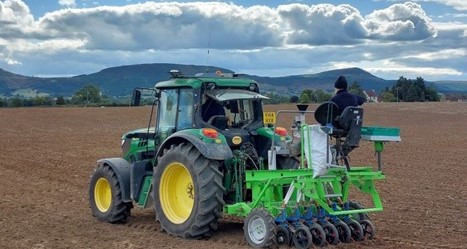How to manage early drilled wheat crops this season
If you've drilled your wheat crop early this year, you may be wondering how to mitigate the challenges that tend to become apparent at this time of the season. Grassweeds, barley yellow dwarf virus (BYDV) and the crop's general nutrition are important to keep on top of when managing your crop.
Weather conditions across the UK
Whether you have drilled your wheat early this year most likely depends on your location in the UK. Further north, around 80 - 90% of early wheat crops have been drilled while further south growers are now in the middle of the main drilling window, with around 60 – 70% expected to be in the ground by the end of the week.
I think the window for early drilling this year is the earliest a lot of us will remember to date. This is partly due to the extremely early harvest we experienced, but it's also likely down to the fact a lot of growers were and are worried about the possibility of non-stop rainfall once it does arrive.
Controlling grassweeds
So far, autumn has been very dry and grassweed germination has been slow, irrespective of low black-grass dormancy levels. Despite this, where crops have been drilled early, grassweeds are now at a point of germination. I suggest any pre-emergence residual sprays are followed up with a post-emergence top-up spray to extend the period of residuality. This gives you the best possible chance to control the grassweeds. A post-emergence top-up spray is particularly important where lower seed rates have been used, which may also result in more open crop cover.
Drilling later allows more time for stale seedbeds, so in circumstances where it's possible I think it's always best to hold your nerve. If tackling grassweeds, something to bear in mind if you use glyphosate is to make sure you follow stewardship guidelines. You can do this by targeting applications when the grassweeds are at the two – three leaf stage and by using a minimum application rate of 540g per hectare. Any surviving plants should be removed mechanically. I also suggest including water conditioners where appropriate and drift retardants to maximise efficacy.
BYDV
There is an increased risk of BYDV with early drilled crops but there are methods to mitigate the impacts.
One of the most effective ways to lessen the BYDV risks in your wheat crop is to manage/minimise the 'green bridge' transmission. This is where you take steps to prevent the aphids or virus left on any surviving green plant material from the previous crop travelling into any new crops. This will of course depend on which crop you had in the rotation beforehand and whether it also had a problem with BYDV. An example of how to mitigate this risk would be to wait five weeks before cultivating, sowing and destroying any weeds.
Given the more unsettled weather over the last week, the total number of aphids recorded in suction traps has declined by around 40%. Rhopalosiphum padi (bird cherry-oat aphid) has declined by 46% across England but still managed to reach three figures in York, Preston, Kirton and Starcross. Live traps of Rhopalosiphum padi at Rothamsted yielded a notably high proportion of cereal colonisers from the 30th September 2022 to the 6th October 2022, with six cereal colonisers recorded out of the 10 tested (60%). The 10-year mean for cereal colonisers is 14% for this time of year, which you can see in the Rothamsted Insect Survey. While only a small proportion of aphids entering cereals likely carry BYDV, problems with spread arise when the second-generation offspring of the original winged colonisers are produced. This is usually the generation that begins to move significantly away from the plant originally colonised. This roughly begins when 170 degree days above a threshold of 3°C (DD>3) have accumulated. DD>3 calculations should begin on the day of emergence or one week after application of pyrethroids. If you think your crop could be affected by BYDV, you can use the AHDB BYDV management tool which uses weather data to predict when a crop is at risk.
Nutrients
Another thing to watch out for in early drilled wheat crops is any nutrient deficiencies, in particular manganese. If your crop does have a deficiency, you should correct it accordingly.
Planning ahead
If you have drilled your wheat crop early this year, it's never too early to start thinking about what you'll need to do in the spring. You should consider the varietal traits of your wheat, particularly the speed it develops at, whether it has any disease risks and the possibility of the crop lodging. It may seem a bit premature to start thinking about these things now but it's much better to be prepared for whatever circumstances the season throws at us.
I hope that the advice outlined above will be a useful reference as you manage your wheat crop throughout the season. If you do have any questions, please speak to your local Frontier contact or get in touch.
As a subscriber, you’ll receive email alerts each time a new blog is published so you can always stay updated with the latest advice and insights from our experts






Comments